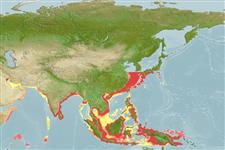Common names from other countries
Environment: milieu / climate zone / depth range / distribution range
Ekologi
; kisaran kedalaman 0 - 175 m (Ref. 109). Tropical; 34°N - 10°S, 48°E - 155°E
Indo-West Pacific: from Persian Gulf to India, east to Papua New Guinea, and north to Japan and China. Introduced in the Mediterranean.
Length at first maturity / Size / Weight / umur
Maturity: Lm 8.6, range 6 - 6.5 cm Max length : 12.9 cm TL jantan/; (Ref. 409); 14 cm TL (female)
Maximum body length: 9.0 cm (male); 14.0 cm (female); common body length between 6.0 to 8.0 cm (Ref. 409). Maximum total length (male) from Ref. 119750. Common length range: 6.5 to 10.9 cm, male. Common weight range: 3.7 to 13.5 cm, male (Ref. 76922). Maximum depth from Ref. 409. Juveniles inhabit subtidal edge of mud flats, near inshore and far inshore waters (Ref. 121464). On muddy bottoms close to the shore, up to a depth of 85 m (Ref. 801). Also found near mouth areas of estuaries (Ref. 106567). Burrows in mud during the day time, with only the tube-like antennular flagella sticking out for respiration (Ref. 409).
Mating behavior: Precopulatory courtship ritual is common (through olfactory and tactile cues); usually indirect sperm transfer (Ref. 833).
rujukan utama
Acuan | Koordinator | mitra
Holthuis, L.B. 1980. (Ref. 8)
Status IUCN Red List (Ref. 130435)
status CITES (Ref. 108899)
Not Evaluated
Not Evaluated
penggunaan manusia
Perikanan: komersial
| FishSource | Sea Around Us
Alat, peralatan
Sumber internet
Estimates based on models
Preferred temperature
(Ref.
115969): 13.8 - 29.1, mean 27.8 (based on 2170 cells).
Daya lenting
Tinggi, Waktu penggandaan populasi minimum kurang dari 15 bulan (K=1.18-2).
keancaman
Low vulnerability (10 of 100).
kategori harga
Unknown.
